Unless you sew your own clothes, you may never have paid close attention to the spot where your sleeve connects to your shirts and hoodies. But this tiny stylistic difference between types of sleeves actually makes a big difference in the formality of a shirt and can also provide more or less ease of movement! So, what are Raglan sleeves, and when should you wear them?
Raglan sleeves attach to the body of a shirt in a diagonal line from the collar to the armpit. This unique sleeve shape provides a better range of movement than other sleeve styles. Popular types of clothing such as long or short sleeves tees, hoodies, pullovers, and Henleys often use a Raglan-style sleeve.
In this article, you will find out what exactly a Raglan sleeve looks like. You will discover key differences between a Raglan-style sleeve and other kinds of sleeves. Finally, you will learn how to sew your own Raglan sleeve with ease.
Quick Navigation
- What Are Raglan Sleeves?
- Advantages of Raglan Sleeves
- What is a Raglan Sleeve T-Shirt?
- What is Raglan Material?
- Raglan Sleeve Measurement
- Types of Raglan Sleeves
- How to Sew a Raglan Sleeve
- Raglan Sleeve Pattern [Free]
- Raglan Sleeve vs Set-In Sleeve: What is the Difference?
- Raglan Sleeve vs Drop Sleeve
- T-Shirt Sleeve vs Raglan Sleeve
- Raglan Sleeve Examples
- Who Should Wear Raglan Sleeves?
- Conclusion
What Are Raglan Sleeves?
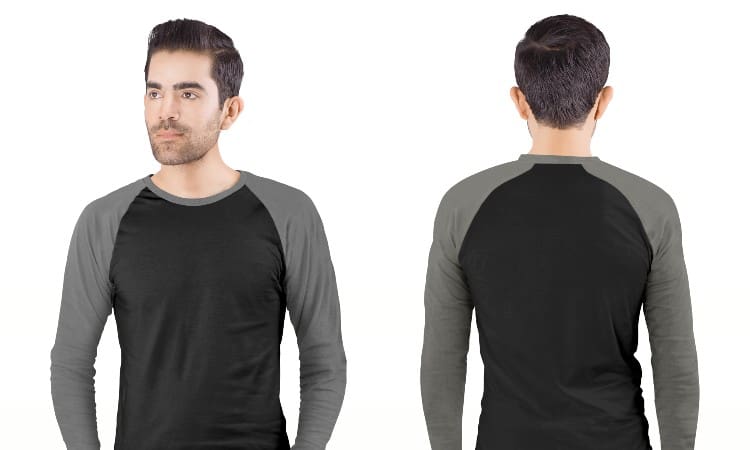
Raglan sleeves attach to a garment in a diagonal line from the armpit seam to the collar and do not have a seam at the shoulder. The two main styles of sleeve attachment used in shirts and other garments are raglan and set-in sleeves. Traditional set-ins use a seam from the armpit to the shoulder to attach a sleeve to a shirt.
The raglan sleeve style is used a lot in t-shirts, long-sleeved tees, henleys, and sweatshirts, though it can have other uses. You see this kind of sleeve a lot in a three-quarter length sleeve and short sleeves for tees and full-length for sweatshirts and cardigans.
For informal tees, raglan sleeves often come in a contrasting color to the body of the shirt. This technique is called color blocking. For instance, you might have a white shirt with red raglan sleeves to show off the unique shape of the sleeve.
But this contrasting color does not actually define a raglan sleeve. The shape of the sleeve defines whether or not a sleeve is a raglan sleeve or a set-in sleeve!
Another common misconception is that raglan shirts are made of “raglan” fabric. There is no “raglan fabric,” though many shirts featuring raglan sleeves use a certain kind of cotton jersey knit. Instead, raglan shirts always contain that special kind of sleeve with a diagonal seam.
Raglan sleeves originated in the 1800s when a famous British general named Lord Raglan lost his arm to a war wound. He wanted a uniform that fit him better following the amputation. To achieve this, he designed the more flexible shape of the raglan sleeve to allow more mobility for sword fighting.
The style gained popularity when baseball teams began to use it in uniform design. Because of this, you sometimes also see shirts with raglan sleeves called “baseball tees.”
Advantages of Raglan Sleeves
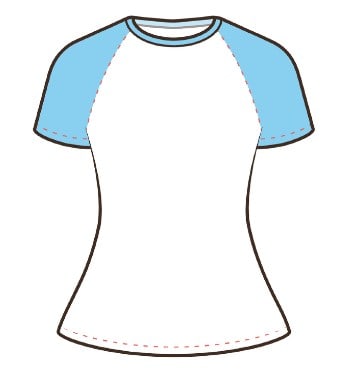 The biggest advantage of a raglan sleeve is that it provides more room in the underarm, thus allowing an easier and broader range of movement. Lots of athletic wear, including sports uniforms, use raglan sleeves for this reason.
The biggest advantage of a raglan sleeve is that it provides more room in the underarm, thus allowing an easier and broader range of movement. Lots of athletic wear, including sports uniforms, use raglan sleeves for this reason.
The diagonal seam from the underarm to the collarbone adds a bit of extra fabric in the part of the sleeve at the armpit. This allows you to reach up, down, and from side to side without tugging on the fabric of the sleeve. You can easily imagine how this extra room helps an athlete to pitch a baseball!
Many casual tops such as t-shirts and henleys also use this kind of sleeve because it feels so comfortable and roomy.
Of course, there’s nothing wrong with a traditional set-in sleeve. Both styles come with advantages and disadvantages, as you will see later in this article! But a raglan sleeve does feel less constricting than a traditional set-in sleeve.
Another minor advantage to a raglan sleeve is that you do not have to worry about the shoulder seam fitting you just right. In this looser style, there is no shoulder seam!
This is always one of those things you have to sort out with a button-down shirt because a shoulder seam that hangs past the edge of your shoulder looks too big, and a shoulder seam resting on your collarbone makes the shirt look too small. The nice thing about raglan sleeves is that you can bypass that whole issue.
Finally, a roomy raglan sleeve in a sweater, hoodie, or jacket allows more room for layering underneath.
What is a Raglan Sleeve T-Shirt?
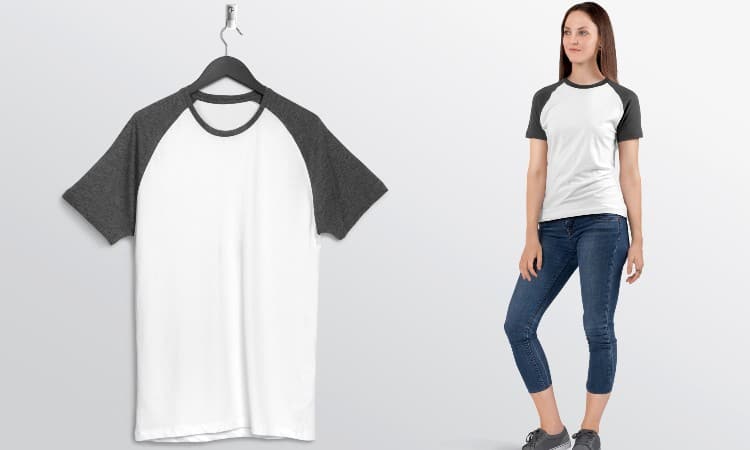
A traditional raglan sleeve t-shirt has three-quarter-length sleeves in a different color from the rest of the shirt and sleeves that attach to the shirt using a diagonal seam from the underarm to the collar. This kind of shirt is usually made out of either cotton jersey knit or a soft tri-blend combining cotton, polyester, and another material such as rayon.
That said, raglan sleeves have gained such popularity that you often see them used in regular tees as well these days. Anyone who works with t-shirts, from sports uniform companies to small-business t-shirt printers, offers a raglan sleeve option these days!
What is Raglan Material?
There is not actually a type of fabric called raglan material, but you will find that most shirts made with raglan sleeves do use a particular kind of fabric called jersey knit. This type of material uses interlocking thread loops that give it a flexible, stretchy construction. The extra stretch in knits makes them perfect for a shirt designed specifically for easy movement!
Jersey knit commonly contains polyester, cotton, or a blend of the two materials. The knitted loops of yarn in this fabric give it stretch and flexibility. You can find jersey knits in various weights, usually between 5 oz to 12 oz for apparel. This determines how thick or thin the material feels between your fingers.
You can also buy plenty of garments that feature raglan sleeves and use other kinds of material, though. For example, waterproof jackets commonly use special waterproof material and have raglan sleeves to allow aid workers, firefighters, and others to move around while wearing a bulky coat.
Raglan Sleeve Measurement
The best way to take a raglan sleeve measurement is to measure from the underarm seam to the cuff. You use this type of measurement to knit sweaters with raglan sleeves or to cut out a sewing pattern using raglan sleeves.
Other common methods for measuring sleeve length include measuring from the collar seam down the top of the arm to the cuff, but you do not see this measurement used as often.
Shirts with set-in sleeves often measure from the shoulder seam to the cuff, but raglan sleeves do not include a shoulder seam! For this reason, make sure you read sizing charts and measurement guides before buying a long-sleeve raglan shirt or hoodie for yourself. This way, you can make sure the sleeve length will fit your arms!
Types of Raglan Sleeves
While the defining characteristic of a raglan sleeve always remains the same, you can find a few modern variations!
- A straight seam raglan sleeve has that classic diagonal line from the underarm to the collar. Usually, this shirt will feature a crew neck or a round neckline.
- A zero raglan sleeve looks quite similar, but in this variation, the diagonal seam does not reach all the way to the collar and instead meets where the neckline and shoulder intersect.
- A raglan yoke shirt looks quite different as it expands in one large piece, called a yoke, across the front of the shirt! You mostly only see this style in women’s apparel. In this type of sleeve, that diagonal line starts at the underarm and then stretches across the chest and the back, connecting the sleeves to the top of the front and back of the shirt.
- A semi-raglan sleeve has a diagonal seam that starts at the underarm but then ends midway inside the shoulder rather than at the collar. It looks a tad bit more like a set-in seam and can highlight strong, muscular shoulders.
- Another popular choice for women’s apparel is the raglan gathered sleeve, which includes gathered material in the diagonal seam to create a full, flouncy, or ruffled sleeve.
How to Sew a Raglan Sleeve
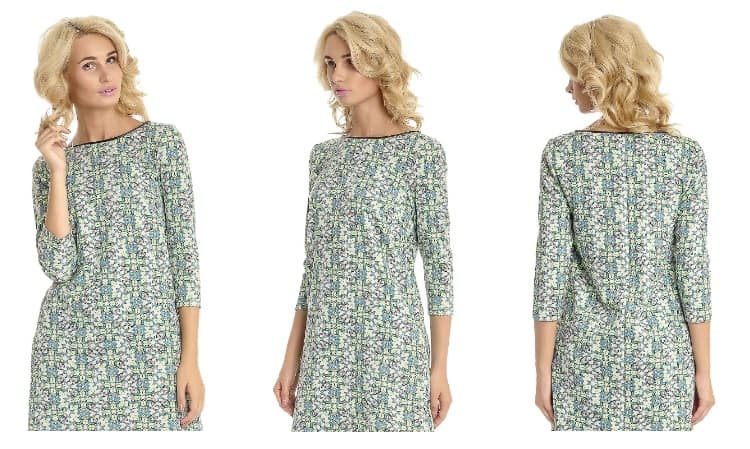
You can sew a raglan sleeve quite easily, which is one of its best qualities! Traditional set-in sleeves sometimes require quite a lot of measuring, mock-ups, and fitting before the circular arm seam will fit your body just right. Raglan sleeves drape easily from the collar to your cuff, and they have a much simpler shape to cut out and sew!
If you plan to use a knit fabric to make a raglan tee or long-sleeved shirt, you may want to use a serger or a sewing machine that offers a stretch stitch option. Regular straight stitching does not work super well on knit materials.
Most raglan shirt patterns will have just three or four pieces to cut out. You will need the shirt front and back, and then just one large piece for each sleeve-it will fold over to meet at an under seam.
- Start by cutting out the pattern pieces for your shirt. Check the next section for a free pattern to get you started! Make sure you align the grainline of the fabric with the selvage edge of the knit fabric and use either pattern weights or pins to hold the pattern in place as you cut.
- Most patterns will come with sewing directions, but in most cases, the next step involves attaching the sleeves to the shirt front. To do this, place the right sides of both pieces together, matching them along the diagonal cut that runs from the collar to the armpit on the sleeve front and the shirt front. Pint this in place, and either sew or serge the seam shut.
- Repeat these steps with the other sleeve, making sure to match the right sides together as you sew the diagonal line matching the sleeve to the front of the shirt.
- Unfold the sleeves and find that diagonal cut on the back of the sleeve. Match the back diagonal to the shirt back, pin in place, and sew or serge.
- Repeat this for the back of the other sleeve as well.
- Now you have a roughly shirt-shaped garment! You still have some unfinished edges, though, so you will want to hem the sleeves next.
- To do this, measure along the hem of the sleeve, marking a point half an inch up. Fold over and press the hem into place, and then use a topstitch to secure it in an attractive way.
- Next, you need to sew the side seams. These seams will run from the hem of the shirt, up to the armpit, and then down the underside of the sleeve to the cuff. Simply sew or serge all the way up this L-shaped hem!
- Hem the bottom of the shirt. If you have a cover stitch machine, you can easily create the perfect hem on knits. Or you can use a sewing machine with a stretch stitch to create a neat topstitched hem.
- As the last step in finishing the shirt, you can leave a raw edge around the collar, as the knit fabric will not fray. Or you can add in a crew neck collar or simply fold under the edge and topstitch around the circle of the neck hole.
Raglan Sleeve Pattern [Free]
Check out these free raglan sleeve pattern options! If you have never sewed this kind of sleeve before, you may want to give it a trial run with a free pattern before spending money at your local sewing shop or craft store.
- This lovely two-colored pattern offers a crewneck and straight-cut raglan sleeves for women.
- This fun pattern allows you to create sleeves tailored to your own body shape! The simple shape of these sleeves makes DIYing your own pattern really easy.
- This basic short-sleeved men’s raglan tee will look perfect with a pair of jeans. Plus, you can find tips for how to sew the shirt on a regular sewing machine without resorting to a serger.
- Looking for a pattern to sew a long-sleeved raglan top? This pattern has you covered!
Raglan Sleeve vs Set-In Sleeve: What is the Difference?
The main difference between a raglan sleeve and a set-in sleeve is the way the sleeve attaches to the shirt’s body. A raglan sleeve has a straight diagonal seam running from the armpit to the collar of the shirt, attaching it to the body of the shirt in a straight line. In contrast, a set-in sleeve has a round sleeve that loops from the armpit to the top of the shoulder and then back down to the armpit on the other side.
A set-in sleeve offers less mobility for the arm than a raglan sleeve. The circular seam running around the shoulder constraints the range of movement more than the loose fit of the raglan sleeve.
That said, fashion trends in business casual or formal wear tend to stick with a sharply defined shoulder seam, which the set-in sleeve provides. The shoulder seam in this style of a sleeve offers a sharp line delineating the end of the shoulder.
If you want to buy shirts in bulk for printing or reselling, you will likely find that shirts with raglan sleeves cost more than shirts with set-in sleeves. Raglan sleeves use a fraction more fabric for the looser underarm, which explains this discrepancy.
Raglan Sleeve vs Drop Sleeve
 The main difference between the raglan sleeve compared to the drop sleeve also lies in how the sleeves attach to the shirt. A drop sleeve has a round armhole seam like a set-in sleeve, but in this case, the shoulder seam falls partway down the upper arm–hence the “drop” sleeve!
The main difference between the raglan sleeve compared to the drop sleeve also lies in how the sleeves attach to the shirt. A drop sleeve has a round armhole seam like a set-in sleeve, but in this case, the shoulder seam falls partway down the upper arm–hence the “drop” sleeve!
Raglan sleeves and drop sleeves have a lot in common in that they both offer a lot of extra space, present a casual vibe, and allow for a free range of movement. But raglan sleeves attach with a seam that runs from the armpit to the collar, while drop sleeves have a shoulder seam that lies several inches past the actual shoulder.
Because drop sleeves attach to the shirt technically the same way as a set-in sleeve, sometimes you see the two kinds of sleeve names used interchangeably. But a drop-sleeve will always have that distinct difference that the shoulder sea hangs over the shoulder. You can think of it as the “baggy boyfriend’s sweater” look.
T-Shirt Sleeve vs Raglan Sleeve
Raglan sleeves attach to the body of the shirt in a different way than a traditional t-shirt, or set-in, sleeve.
Benefits of choosing a raglan sleeve in a t-shirt include:
- You can easily use color blocking–using contrasting fabric colors–to highlight the unique shape of the sleeve.
- More fabric in the looser underarm makes this style more flexible and easier to move in. This kind of sleeve works perfectly for athletic wear, casual wear, or sports uniforms.
- This kind of sleeve can highlight muscular shoulders or blur the lines of a rounder figure, making it a great choice for certain body types.
Benefits of a traditional set-in t-shirt sleeve include:
- This style of sleeve costs less, both because it uses slightly less fabric and because more factories have the equipment to sew these sleeves.
- For a more formal occasion, a traditional t-shirt sleeve will provide a crisp, distinct shoulder line.
- A set-in sleeve lies closer to the body and can make certain body types look much slimmer than a baggier raglan sleeve.
Raglan Sleeve Examples
For a quick overview of raglan sleeve styles, check out these popular products!
Hanes Women’s Cotton Raglan Sleeve
 This cozy tee comes in six different colors and has a wide neckline and three-quarter length sleeves.
This cozy tee comes in six different colors and has a wide neckline and three-quarter length sleeves.
It features a blended fabric containing 95% cotton 5% spandex in a stretchy jersey knit. The oval collar and casual drape of the sleeves give this loose shirt a lot of extra room to fit any body type.
Plus, Hanes provides the added comfort of a tagless collar. You can count on this soft shirt to move with you throughout the day!
H2H Henley Raglan Sleeves Men
 This stylish henley has a three-button opening at the neck and forty-four different color combos to choose from!
This stylish henley has a three-button opening at the neck and forty-four different color combos to choose from!
The round neckline and raglan sleeves will provide extra flexibility and movement as you wear this comfortable shirt. The fabric contains 60% cotton and 40% polyester for an affordable, soft blended fabric.
This slim-fit style will accentuate a slim torso or highlight broad shoulders, allowing you to look both casual and classy at the same time!
Men’s Dri-Power Raglan Sleeve Hoodie
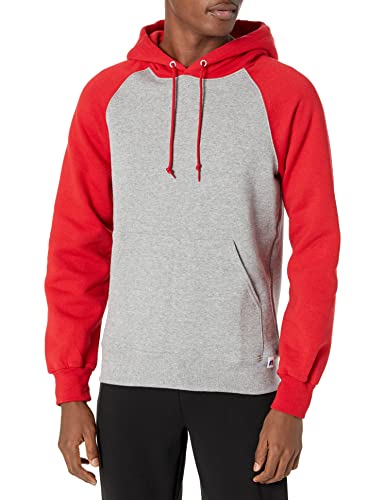 Looking for a warm, cozy pullover hoodie with sleeves that easily let you move your arms?
This hoodie features 9 oz fleece for extra warmth and offers Dri-Power moisture-wicking technology for a sweaty winter workout.
Looking for a warm, cozy pullover hoodie with sleeves that easily let you move your arms?
This hoodie features 9 oz fleece for extra warmth and offers Dri-Power moisture-wicking technology for a sweaty winter workout.
The raglan sleeves come in 12 different color combos.
A drawstring hood and a muff pocket provide more warmth and fun stylistic accents. Plus, the loose raglan sleeves will easily fit over any base layers!
Who Should Wear Raglan Sleeves?
Raglan sleeves look good on anyone going for a casual style, but they can also help highlight or downplay certain body types.
For example, raglan sleeves can help de-accentuate broad shoulders if you want to present a more slender silhouette. They can also look great on anyone with a curvier body type, as the looser sleeve will not closely outline the shape of the shoulder and arm.
That said, you may find that raglan sleeves don’t look great if you tend to have hunched or sloped shoulders, as this could highlight your build in a negative way.
Raglan tops pair great with jeans and zip-up hoodies left open at the front. They also blend in at the beach, mall, or with your pajama bottoms at home on the couch!
Conclusion
Raglan sleeves have a unique shape that provides extra room in the underarm, allowing a wide range of movement. The sleeve attaches to the body of the garment in a different way than a traditional sleeve as well, with a straight seam running from beneath the arm to the collar. The unique shape of this kind of sleeve makes it easy to sew.
The most popular use of raglan sleeves is in casual jersey-knit tops with three-quarter length sleeves in a contrasting color. But many other types of garments, including sporting jackets and baseball uniforms, also employ this loose sleeve style to allow ease of movement.
If you look at your clothes, can you spot some raglan sleeves? Do you find this style of sleeve more or less comfortable than a traditional set-in sleeve? Leave a comment below to let us know!